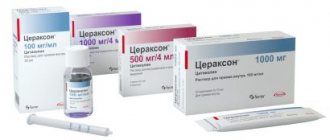Pharmacological properties of the drug Ceraxon
Citicoline stimulates the biosynthesis of structural phospholipids in neuronal membranes, which improves membrane function, including the functioning of ion exchange pumps and neuroreceptors. Due to its stabilizing effect on the membrane, citicoline has anti-edematous properties and reduces cerebral edema. Citicoline reduces the severity of symptoms of cerebral dysfunction after pathological processes such as traumatic brain injury or acute cerebrovascular accidents. Citicoline reduces the level of amnesia, improves the condition of cognitive, sensory and motor disorders, and also weakens the severity of symptoms that are observed with hypoxia and cerebral ischemia, including memory impairment, emotional lability, and impaired ability to perform normal self-care activities. Citicoline is a natural compound found in the human body, so classical pharmacokinetic studies cannot be performed due to the difficulty of quantifying exogenous and endogenous citicoline. During a pharmacokinetic study, its almost complete absorption in the gastrointestinal tract was determined - less than 1% of the dose taken was detected in the feces within 5 days after taking the drug. Two peaks of radioactivity were also noted in the blood plasma, due to metabolism in the liver and intestines: the first - after 1 hour, the second - after 24 hours. Bioavailability by oral and parenteral routes of administration is almost the same. Excretion is very slow, mainly through the respiratory system and urine. After 5 days of administration, about 16% of the drug dose was detected, which indicates the inclusion of the rest of the dose in metabolic processes.
Ceraxon solution for internal use 100 mg/ml 30 ml
Active substance
citicoline
ATX code
N06BX06 (Citicoline)
Dosage forms
oral solution
Release form, packaging and composition of the drug
Oral solution
- a clear, colorless liquid with a characteristic strawberry odor.
| 1 ml | |
| citicoline sodium | 104.5 mg, |
| equivalent to citicoline | 100 mg |
[PRING] sorbitol - 200 mg, glycerol - 50 mg, methyl parahydroxybenzoate - 1.45 mg, propyl parahydroxybenzoate - 0.25 mg, sodium citrate dihydrate - 6 mg, sodium saccharinate - 0.2 mg, strawberry flavor (strawberry essence 1487-S-Lucta) - 0.408 mg , potassium sorbate - 3 mg, citric acid solution 50% - up to pH 5.9-6.1, purified water - up to 1 ml.
30 ml - colorless glass bottles (1) complete with a dosage syringe - cardboard packs with partitions.
Oral solution
- a clear, colorless liquid with a characteristic strawberry odor.
| 1 pack (10 ml) | |
| citicoline sodium | 1045 mg, |
| equivalent to citicoline | 1000 mg |
[PRING] sorbitol - 2000 mg, glycerol - 500 mg, methyl parahydroxybenzoate - 14.5 mg, propyl parahydroxybenzoate - 2.5 mg, sodium citrate dihydrate - 60 mg, sodium saccharinate - 2 mg, strawberry flavor (strawberry essence 1487-S-Lucta) - 4.08 mg , potassium sorbate - 30 mg, citric acid solution 50% - up to pH 5.9-6.1, purified water - up to 10 ml.
10 ml - sachets of combined material (6) - cardboard packs. 10 ml - sachets of combined material (10) - cardboard packs.
Clinical and pharmacological group
Nootropic drug
Pharmacotherapeutic group
Nootropic drug
pharmachologic effect
Suction
Citicoline is well absorbed when taken orally. Absorption after oral administration is almost complete, and bioavailability is approximately the same as after intravenous administration.
Metabolism
The drug is metabolized in the intestines and liver with the formation of choline and cytidine. After oral administration, the concentration of choline in the blood plasma increases significantly.
Distribution
Citicoline is widely distributed in brain structures, with rapid incorporation of choline fractions into structural phospholipids and cytidine fractions into cytidine nucleotides and nucleic acids. Citicoline penetrates the brain and is actively incorporated into cellular, cytoplasmic and mitochondrial membranes, forming part of the fraction of structural phospholipids.
Removal
Only 15% of the administered dose of citicoline is excreted from the human body; less than 3% - by the kidneys and about 12% - with exhaled CO2.
The excretion of citicoline in urine can be divided into 2 phases: a first phase, lasting about 36 hours, during which the rate of excretion decreases rapidly, and a second phase, during which the rate of excretion decreases much more slowly. The same is observed in exhaled CO2 - the rate of elimination decreases rapidly after about 15 hours and then decreases much more slowly.
Indications for use
- acute period of ischemic stroke (as part of complex therapy);
- recovery period of ischemic and hemorrhagic strokes;
- traumatic brain injury, acute (as part of complex therapy) and recovery period;
- cognitive and behavioral disorders in degenerative and vascular diseases of the brain.
Dosage
The drug is taken with meals or between meals. Before use, the drug can be diluted in a small amount of water (120 ml or 1/2 cup).
Acute period of ischemic stroke and traumatic brain injury:
The recommended dose is 1000 mg (10 ml or 1 sachet) every 12 hours. The duration of treatment is at least 6 weeks.
Recovery period of ischemic and hemorrhagic strokes, recovery period of traumatic brain injury, cognitive and behavioral disorders in degenerative and vascular diseases of the brain:
The recommended dose is 500-2000 mg/day (5-10 ml 1-2 times/day or 1 sachet (1000 mg) 1-2 times/day). The dose and duration of treatment depend on the severity of the symptoms of the disease.
Elderly patients
No dose adjustment of Ceraxon® is required.
Rules for using a dosage syringe
1. Place the dosing syringe into the bottle (the syringe plunger is completely lowered).
2. Carefully pull the plunger of the dosing syringe until the solution level is equal to the corresponding mark on the syringe.
3. Before taking, the required amount of solution can be diluted in 1/2 glass of water (120 ml).
After each use, it is recommended to rinse the dosing syringe with water.
Rules for using the drug in sachets
1. Holding the bag vertically, carefully tear off its edge along the o.
2.The contents of the sachet can be drunk immediately after opening or before use can be diluted in 1/2 glass of water (120 ml).
Contraindications
- pronounced vagotonia (predominance of the tone of the parasympathetic part of the autonomic nervous system);
- children and adolescents under 18 years of age (due to the lack of sufficient clinical data);
- rare hereditary diseases associated with fructose intolerance;
- hypersensitivity to the components of the drug.
Overdose
Due to the low toxicity of the drug, cases of overdose have not been described.
Side effects
Very rare (<1/10,000) (including individual cases):
allergic reactions (rash, skin itching, anaphylactic shock), headache, dizziness, feeling of heat, tremor, nausea, vomiting, diarrhea, hallucinations, swelling, shortness of breath, insomnia, agitation, loss of appetite, numbness in paralyzed limbs, changes in the activity of liver enzymes . In some cases, Ceraxon® can stimulate the parasympathetic system and also cause a short-term change in blood pressure.
If any of the side effects indicated in the instructions get worse, or any other side effects not listed in the instructions are noticed, you should inform your doctor.
Overdose
Citicoline enhances the effects of levodopa.
Ceraxon® should not be prescribed concomitantly with medications containing meclofenoxate.
Storage conditions
The drug should be stored out of the reach of children at a temperature not exceeding 30°C. Shelf life: 3 years.
Conditions for dispensing from pharmacies
The drug is available with a prescription.
Special Instructions
In the solution for oral administration in the cold, a small amount of crystals may form due to temporary partial crystallization of the preservative. With further storage under recommended conditions, the crystals dissolve within several months. The presence of crystals does not affect the quality of the drug.
Impact on the ability to drive vehicles and operate machinery
During the treatment period, patients should be careful when performing potentially hazardous activities that require special attention and speed of psychomotor reactions (including driving a car and other vehicles, working with moving mechanisms, working as a dispatcher and operator).
Use of the drug Ceraxon
The solution for oral use in adults is prescribed 200 mg (2 ml) orally 3 times a day. For children, the drug can be prescribed orally from the moment of birth - 100 mg (1 ml) 2-3 times a day. The duration of treatment depends on the severity of the brain damage. The minimum recommended period is 45 days. The dose of the drug and the duration of treatment can be changed by the doctor. The drug, pre-mixed with a small amount of water, is taken using a dosing syringe. It is necessary to rinse the dosing syringe with water after each use. IV or IM administration In acute and emergency conditions, the maximum therapeutic effect is achieved when the drug is administered in the first 24 hours. IV is administered slowly (injection duration - 5 minutes) or drip (infusion rate - 40-60 drops per minute) . Treatment begins with prescribing the drug for the first 2 weeks, 500–1000 mg (depending on the patient’s condition) 2 times a day intravenously. Then - 500–1000 mg 2 times a day IM. The maximum daily dose is 2000 mg. If necessary, treatment is continued with the drug in the form of an oral solution. The recommended duration of treatment, at which the maximum therapeutic effect is noted, is 12 weeks. It is recommended for children to prescribe Ceraxon in the form of a solution for oral use.
Buy Ceraxon solution intravenously and intramuscularly 500 mg 4 ml No. 5 in pharmacies
The solution for intravenous and intramuscular administration is a clear, colorless liquid. Indications : acute period of ischemic stroke (as part of complex therapy); — recovery period of ischemic and hemorrhagic strokes; — traumatic brain injury, acute (as part of complex therapy) and recovery period; — cognitive and behavioral disorders in degenerative and vascular diseases of the brain. Dosage regimen IV drug is administered as a slow injection (over 3-5 minutes, depending on the prescribed dose) or drip infusion (40-60 drops/min). The intravenous route of administration is preferable to the intramuscular route. When administered intramuscularly, repeated administration of the drug in the same place should be avoided. Acute period of ischemic stroke and traumatic brain injury: the recommended dose is 1000 mg every 12 hours from the first day after diagnosis; Duration of treatment is at least 6 weeks. 3-5 days after the start of treatment (if swallowing function is not impaired), it is possible to switch to oral forms of the drug Ceraxon®. Recovery period for ischemic and hemorrhagic strokes, recovery period for traumatic brain injury, cognitive and behavioral disorders in degenerative and vascular diseases of the brain: the recommended dose is 500-2000 mg/day (5-10 ml 1-2 times/day). The dose and duration of treatment depend on the severity of the symptoms of the disease. Elderly patients do not require dose adjustment of Ceraxon® for intravenous or intramuscular administration. A solution for intravenous and intramuscular administration in an ampoule is intended for single use. After opening the ampoule, the solution should be used immediately. The drug is compatible with all types of intravenous isotonic solutions and dextrose solutions. Side effects Very rare (<1/10,000) (including individual cases): allergic reactions (rash, itching, anaphylactic shock), headache, dizziness, feeling of heat, tremor, nausea, vomiting, diarrhea, hallucinations, swelling, shortness of breath , insomnia, agitation, loss of appetite, numbness in paralyzed limbs, changes in the activity of liver enzymes. In some cases, Ceraxon® can stimulate the parasympathetic system and also cause a short-term change in blood pressure. If any of the side effects indicated in the instructions get worse, or any other side effects not listed in the instructions are noticed, you should inform your doctor. Contraindications for use : severe vagotonia (predominance of the tone of the parasympathetic part of the autonomic nervous system); - children and adolescents under 18 years of age (due to the lack of sufficient clinical data); - hypersensitivity to the components of the drug. Use during pregnancy and lactation There is not enough clinical data on the use of citicoline during pregnancy. Although experimental studies on animals have not revealed any negative effects, during pregnancy the drug is prescribed only when the expected benefit of therapy for the mother outweighs the potential risk to the fetus. If it is necessary to use the drug during lactation, the issue of stopping breastfeeding should be decided, since there is no data on the excretion of citicoline in breast milk. Use in children Contraindicated in children and adolescents under 18 years of age. Use in elderly patients Elderly patients do not require dose adjustment of Ceraxon®. Special instructions Impact on the ability to drive vehicles and operate machinery During the treatment period, patients should be careful when performing potentially dangerous activities that require special attention and speed of psychomotor reactions (including driving a car and other vehicles, working with moving mechanisms, work of the dispatcher and operator). Overdose Due to the low toxicity of the drug, cases of overdose have not been described. Drug interactions Citicoline enhances the effects of levodopa. Ceraxon® should not be prescribed concomitantly with medications containing meclofenoxate. Conditions and periods of storage The drug should be stored out of the reach of children at a temperature not exceeding 30°C. Shelf life: 3 years. Conditions for dispensing from pharmacies The drug is dispensed with a prescription.
Special instructions for the use of the drug Ceraxon
There are no age restrictions for oral use of the drug. Pregnancy and lactation Although no evidence of risk to the fetus has been obtained when using the drug, during pregnancy the drug is used only when the expected benefit outweighs the potential risk. There are no data on the passage of citicoline into breast milk and its effect on the fetus is unknown. Effect on the ability to drive vehicles and operate complex mechanisms. Citicoline does not affect the ability to drive vehicles and operate complex mechanisms.









